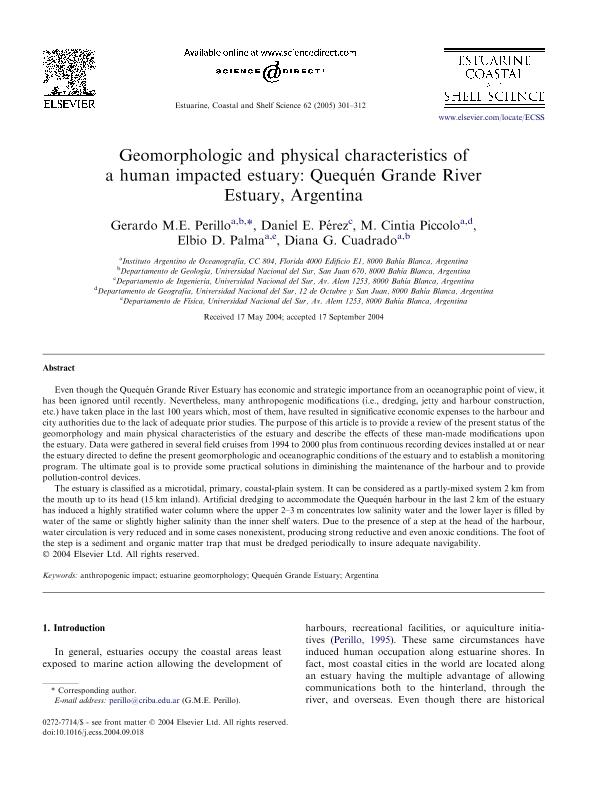Mostrar el registro sencillo del ítem
dc.contributor.author
Perillo, Gerardo Miguel E.

dc.contributor.author
Pérez, Daniel Roberto

dc.contributor.author
Piccolo, Maria Cintia

dc.contributor.author
Palma, Elbio Daniel

dc.contributor.author
Cuadrado, Diana Graciela

dc.date.available
2017-11-23T14:34:31Z
dc.date.issued
2005-12
dc.identifier.citation
Perillo, Gerardo Miguel E.; Pérez, Daniel Roberto; Piccolo, Maria Cintia; Palma, Elbio Daniel; Cuadrado, Diana Graciela; Geomorphologic and physical characteristics of a human impacted estuary: Quequén Grande River Estuary, Argentina; Academic Press Ltd - Elsevier Science Ltd; Estuarine, Coastal and Shelf Science; 62; 1-2; 12-2005; 301-312
dc.identifier.issn
0272-7714
dc.identifier.uri
http://hdl.handle.net/11336/28822
dc.description.abstract
Even though the Quequén Grande River Estuary has economic and strategic importance from an oceanographic point of view, it has been ignored until recently. Nevertheless, many anthropogenic modifications (i.e., dredging, jetty and harbour construction, etc.) have taken place in the last 100 years which, most of them, have resulted in significative economic expenses to the harbour and city authorities due to the lack of adequate prior studies. The purpose of this article is to provide a review of the present status of the geomorphology and main physical characteristics of the estuary and describe the effects of these man-made modifications upon the estuary. Data were gathered in several field cruises from 1994 to 2000 plus from continuous recording devices installed at or near the estuary directed to define the present geomorphologic and oceanographic conditions of the estuary and to establish a monitoring program. The ultimate goal is to provide some practical solutions in diminishing the maintenance of the harbour and to provide pollution-control devices. The estuary is classified as a microtidal, primary, coastal-plain system. It can be considered as a partly-mixed system 2 km from the mouth up to its head (15 km inland). Artificial dredging to accommodate the Quequén harbour in the last 2 km of the estuary has induced a highly stratified water column where the upper 2-3 m concentrates low salinity water and the lower layer is filled by water of the same or slightly higher salinity than the inner shelf waters. Due to the presence of a step at the head of the harbour, water circulation is very reduced and in some cases nonexistent, producing strong reductive and even anoxic conditions. The foot of the step is a sediment and organic matter trap that must be dredged periodically to insure adequate navigability.
dc.format
application/pdf
dc.language.iso
eng
dc.publisher
Academic Press Ltd - Elsevier Science Ltd

dc.rights
info:eu-repo/semantics/openAccess
dc.rights.uri
https://creativecommons.org/licenses/by-nc-sa/2.5/ar/
dc.subject
ANTHROPOGENIC IMPACT
dc.subject
ARGENTINA
dc.subject
ESTUARINE GEOMORPHOLOGY
dc.subject
QUEQUÉN GRANDE ESTUARY
dc.subject.classification
Meteorología y Ciencias Atmosféricas

dc.subject.classification
Ciencias de la Tierra y relacionadas con el Medio Ambiente

dc.subject.classification
CIENCIAS NATURALES Y EXACTAS

dc.title
Geomorphologic and physical characteristics of a human impacted estuary: Quequén Grande River Estuary, Argentina
dc.type
info:eu-repo/semantics/article
dc.type
info:ar-repo/semantics/artículo
dc.type
info:eu-repo/semantics/publishedVersion
dc.date.updated
2017-11-21T13:55:04Z
dc.journal.volume
62
dc.journal.number
1-2
dc.journal.pagination
301-312
dc.journal.pais
Estados Unidos

dc.description.fil
Fil: Perillo, Gerardo Miguel E.. Consejo Nacional de Investigaciones Científicas y Técnicas. Centro Científico Tecnológico Conicet - Bahía Blanca. Instituto Argentino de Oceanografía. Universidad Nacional del Sur. Instituto Argentino de Oceanografía; Argentina. Universidad Nacional del Sur. Departamento de Geología; Argentina
dc.description.fil
Fil: Pérez, Daniel Roberto. Universidad Nacional del Sur; Argentina
dc.description.fil
Fil: Piccolo, Maria Cintia. Consejo Nacional de Investigaciones Científicas y Técnicas. Centro Científico Tecnológico Conicet - Bahía Blanca. Instituto Argentino de Oceanografía. Universidad Nacional del Sur. Instituto Argentino de Oceanografía; Argentina. Universidad Nacional del Sur. Departamento de Geografía y Turismo; Argentina
dc.description.fil
Fil: Palma, Elbio Daniel. Consejo Nacional de Investigaciones Científicas y Técnicas. Centro Científico Tecnológico Conicet - Bahía Blanca. Instituto Argentino de Oceanografía. Universidad Nacional del Sur. Instituto Argentino de Oceanografía; Argentina. Universidad Nacional del Sur. Departamento de Física; Argentina
dc.description.fil
Fil: Cuadrado, Diana Graciela. Consejo Nacional de Investigaciones Científicas y Técnicas. Centro Científico Tecnológico Conicet - Bahía Blanca. Instituto Argentino de Oceanografía. Universidad Nacional del Sur. Instituto Argentino de Oceanografía; Argentina. Universidad Nacional del Sur. Departamento de Geología; Argentina
dc.journal.title
Estuarine, Coastal and Shelf Science

dc.relation.alternativeid
info:eu-repo/semantics/altIdentifier/doi/http://dx.doi.org/10.1016/j.ecss.2004.09.018
dc.relation.alternativeid
info:eu-repo/semantics/altIdentifier/url/http://www.sciencedirect.com/science/article/pii/S0272771404002537
Archivos asociados
